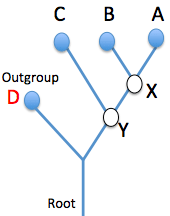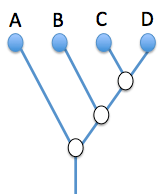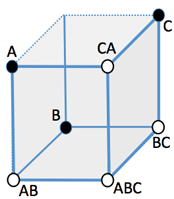 |
The World of Dendrogram Thinking- Everything is together with trees -
|
Category: SCI |
Nobuhiro Minaka (三中信宏) |
11817u/18211r |
Title
The World of Dendrogram Thinking
系統樹思考の世界
Index
Tag
; Abduction; Cladistics; Comparative method; Dendrogram way; Distorted glass; Explanation by narrative; Fitness; Great Chain of Being; Intellectual guess; Lonely road; Jungle structure; Parsimony; Phylogenetic revolution; Self-searching journey; Super tree structure; Tree of Life; Type & token; Typical science;
Why?
- There is a chasm of methodology in natural science between physics-chemistry vs. geology-biology.
- This book is unique and interesting; which make us evolve to awake the importance of evolutional tree or phyletic tree structure.
- 自然科学の中で、物理化学と地学生物学の間に大きな溝がある。
- 本書はユニークでおもしろい。それは系統樹の構造の重要性に気づくように我々を進化させてくれる。
Key
phrase
Remarks
>Top 0. Preface:
- "The Origin of Species", 1859, Charles Darwin
- decent with modification
- evolutionary thinking
- Dendrogram way of thinking:
- It is not only living creatures which evolve; both animate and inanimate being, natural and artificial things.
- history of font type: Garamont (16C), Caslon (18C), Times (1932).
- Trajanus' epigraph - the common ancestor 。 of font types.
- x-height, ascender, descender, axis
- sense of beauty and legibility
- living organism: natural selection against genetic random variance in a group.
- >Top Icon of tree:
- "the Tree of Life" born at Mesopotamia civilization.
- Wandering or roving is a process of discovery.
- Mobius strip: two sides are inextricably linked
0.
序:
- "種の起源", 1859, C.ダーウィン
- 変化を伴う由来
- 進化的思考
- 系統樹的思考:
- 進化するのは生き物だけではない。生物も非生物も、自然も人工物も
- 欧文書フォントの歴史:
- ギャラモン(16C)
- キャズロン(18C)
- タイムズ(1932)
- トラヤヌス帝の碑文がルーツ
- 審美眼と可読性によって淘汰
- 生物:集団内のランダムな遺伝変異に対して自然淘汰作用
- イコンの系譜:
- "生命の寿"、メソポタミア文明で誕生
- さまようことは発見の道程
- メビウスの輪:表裏区別できず
>Top
1. Dendrogram as a history:
- Standard of typical science:
- able to observe
- able to experiment
- able to repeat
- able to estimate
- able to generalize
- Hypothesis or theory must be verified by
empirical data.
- baptized by data
- Scientific standard is not monolithic.
- different type of science requires different standard.
- local scientific philosophy based on individual case study such as study for evolution or genealogy, or history.
- Classification is our inherent ability as well as inductive reasoning based on observation or experiments.
- >Top Style of inference:
- Deduction: inference in which the conclusion about particulars follows necessarily from general or universal premises.
- Induction: inference of a generalize conclusion from particular instances.
- Mathematical induction: it holds for the integer 1 and that if it holds for an arbitrarily chosen positive integer k, it must hold for the integer k+1.
- Abduction: (Hypothesis selection standard)
1.
歴史としての系統樹:
- 典型科学の基準:
- 観察可能
- 実験可能
- 反復可能
- 予測可能
- 一般化可能
- 仮説や理論は、経験的データによって検証が必要:
- データによる洗礼
- 科学の基準は一枚岩ではない:
- 異なる科学には異なる基準あり
- 個別ケーススタディに基づくローカルな科学哲学:進化学、系統学、歴史
- 分類することは我々の生得的能力で、同様に、観察や実験を通じた帰納的な推論も同じ
- 推論様式
- 演繹:前提となる命題が論理的に真であれば、それから演繹される命題も真である。
- 帰納:観察されたデータを蓄積することにより、真である普遍法則が導かれる。
- 仮説選択基準 (アブダクション)
- >Top Data is neither 'open window' believed by positivists, nor 'hindering closed W wall' stressed by skeptics, but is compared to a kind of 'distorted glass.'; Ginsburg, 2001
- Such distorted glass gives weaker relationship between true or false.
- Distorted glass means degree of experimental support; i.e. mostly supported hypothesis could be most probable answer.
- This methodology does not ask back theoretical true or not, but to pursue 'better explanation' backed by relatively many of observational data.
- Abduction relates such key words as 'Ockham's razor', 'likelihood', or 'model selection.'
- >Top Explanation by narrative:
- Narrative is a kind of style which explains the past events.
- Scientists try to submit various hypotheses.
- It nether excellency of the narrative nor the process of explanation which decides the answer, but is real data and background knowledge.
- Is history a rhetoric?
- if narrative encounters fictional story and real affair in a single and fused description, one can concurrently understand both of attraction and negation of the story.
- Such narrative should be narrowed down by more data to be plausible historical story.
- データは"開かれた窓"でも、"視界を妨げる壁"でもない。それは"ゆがんだガラス"である。
- ゆがんだガラスは、真偽の中間の弱い関係を与える。
- ゆがんだガラスとは、経験的支持の程度、すなわち、最も多く支持された仮説。
- この方法論は理論の真偽を問うのではなく、観測データの下で、より良い説明の相対比較である。
- アブダクションは、オッカムの剃刀、尤度、モデル選択と関連。
- 物語による説明:
- もし物語が、架空の事柄と現実の事柄とを一つの叙述の中で出会わせ、融合させるならば、物語の魅力と物語を拒絶することが同時に可能。
- この物語は、多くのデータによって絞り込まれ、あり得そうな歴史物語となる。
- >Top Type and token:
- Type is a group or a class which has common features, while token is an individual or event which represents a group.
- Universalienstreit:
- Realism: a theory that objects of sense perception or cognition exist independently of the mind.
- Nominalism: a theory that there are no universal essences in reality and that the mind can frame no single concept or image corresponding to any universal or general term.
- science pursuing universal law has discussed about 'type', while science of history or evolution has considered about 'token.'
- >Top Fitness:
- the capacity of an organism to survive and transmit its genotype to reproductive offspring as compared to competing organisms.
- Reciprocal studies:
- Even a study of type may pursue historical estimation, while a study of token may examine universal law.
- Scientific object and methodology should be more flexible.
- タイプとトークン:
- タイプはある特徴を共有する要素の集まり、トークンは個々のものないしは唯一の出来事
- 普遍論争(中性スコラ哲学の論争)
- 実念論:プラトンのイデア論を継承して個体に先立つ客観的実在性をもつとすs関する議論をしてきた。一方、歴史や進化を論じる科学は、トークンの考察をしてきた。
- 適応度(fitness):
- ある環境条件の下で、生物の生存や繁殖に有利な遺伝子は、自然淘汰によって集団中でその頻度を増やす
- 相互乗り入れ的研究:
- タイプの研究でも歴史的推定を追求しており、一方でトークンの分野でも普遍的な法則を研究している。
- 科学的な対象や方法論はもっとフレキシブルであるべき。
>Top 2. Dendrogram as a language:
- There is no definite classification in academics.
- Specific field has each uniqueness.
- Every classification has its own classification criterion. It the criterion changes, the classification varies.
- A researcher should not settle for a ready-built house.
- >Top The Great Chain of Being": 13C Medieval philosophy
- God> angel > human being > animal > plant > material
- Relative principles: difference, accordance, conflict; edge, intermediate, end; majority, equality, minority
- tree structure vs. chain structure
- Classification itself is a good communication.
- Encyclopedic classification: D'Alembert (18C)
- Reason - Philosophy:
- Metaphysics
- Theology
- Anthropology
- Natural science
- Memory - History:
- History of God
- History of Church
- History of Human
- History of Nature
- Imagination - Art:
- >Top Branched pattern avails to memorize rather than to understand them.
- Academic wall seems lower than our expectation, or is no more than illusion.
- William Whewell, 19C:
- advocated Philosophy of science and scientist
- inductive sciences; based on objective facts
- pure sciences; time, space, & number
- Palaetiology < Aetiology = branch of knowledge concerned with causes
- to study causal laws of past events
- historical science including geology, etymology, philology, archaeology
2.
言葉としての系統樹:
- 絶対的な学問分類はない:
- 個々の分野は唯一性
- すべての分類には基準がある。基準を変えると分類体系は変わる。
- 研究者は、"建売住宅"に安住すべきでない
- ツリー構造とチェイン構造
- 分類自身はよいコミュニケーション
- 13C 中世の哲学:
- 偉大な存在チェイン:
- 神>天使>人間>動物>植物>物質
- 分類することは良いコミュニケーション
- 百科全書分類:ダランベール(18C)
- 理性 - 哲学:
- 形而上学
- 神学
- 人間学
- 自然学
- 記憶 - 歴史
- 神の歴史
- 教会の歴史
- 人間の歴史
- 自然の歴史
- 想像 - 芸術
- 分類のパターンは理解するよりも記憶に役立つ
- 学問的な壁は予想以上に低い。あるいは幻影に過ぎない。
- ウイリアム・ヒューウェル, 19C:
- 科学哲学と科学者と提唱
- 帰納科学:客観的事実に基づく
- 純粋科学
- 古因学:原因を論じる科学は因果学(aetiology)
- 歴史学:地質学、語減額、文献学、考古学を含む
- >Top Chronological variation and spatial variation:
- Comparative method is a tool for abduction through examining cause and effect
- biology includes morphology, behavioristics, ecology, DNA analysis, etc.
- biogeography, environmental geography
- systematics merges phylogeny and biogeography.
- Extension or crossover of comparative science:
- Evolution of language, manuscript, folklore, culture
- Bunzo Hayata (1874-1934): systematic biology
- flora in Taiwan (1911-1921)
- >Top Phylogenetic revolution: 1990 -
- increase of phylogentics thesis
- tree-thinking and group-thinking:
- tree-thinking: genealogic relationship of divergent order
- group-thinking: discrete categorization of the present objects considering their 'essence.'
- essentialism competes with evolutionary thinking
- Darwinism assumes 'population-thinking.':
dendrogram as a pattern and natural selection as a process.
- 時間的変化と空間的変化
- 比較法は、原因結果の分析を通じてアブダクションを実行するツール
- 生物学:形態・生理・行動・生態を含む
- 生物地理学、環境地理学
- 体系学は、系統発生と生物地理の融合
- 比較学の延長・交差:
- 言語・写本・民俗・文化の進化
- 早田文蔵 (1874-1934):植物分類学
- "系統樹革命" Davi M. ヒリス
- 系統樹思考と分類思考:
- 系統樹思考:分岐順序の系譜関係
- 分類思考:現在の対象の本質を考慮した離散カテゴリー化
- 本質主義は、進化思考と矛盾する。
- ダーウィン主義は、集団思考が前提:
パターンとしての系統樹とプロセスとしての自然淘汰
>Top 3. Dendrogram as an inference:
 To estimate the best dendrogram:
To estimate the best dendrogram:
- ● (A/B/C): Ingroup: real creature whose data was obtained
- ○: virtual common ancestor
- ● (D): Outergroup: distantly-related creature
- Decision criterion of a hypothesis:
- principle of parsimony
- >Top Intellectual guess:
(Josephson & Susan, 1994)
- Hypothesis (H) is far better than other alternative hypotheses (H')
- (H) is substantially appropriate.
- Data (D) are reliable.
- Group of (H') are comprehensively compared.
- The cases of (H) is correct or incorrect are considered.
- The necessity of selection of (H) is considered.
- Difference from deduction or induction method:
- Deduction or induction method depends on authenticity (true or not) of the hypothesis.
- But Abduction method depends on quality (right or wrong) of hypotheses.
- However, the decision of quality does not uniquely decides.
- >Top The principle of parsimony is one of these decision principles.
- Case of manuscript family tree:
- accidental miss
- referential miss
- shared miss: mostly not accidental
- unique miss:
3.
推論としての系統樹:
- ベストの系統樹を推定する:
<左図>
- ●:内群:データが得られた生物;A/B/C
- ○:仮の共通の祖先
- ●:外群:遠縁の生物
- 仮説の判定基準:
- 最節約性:
- 知的推測:
- 仮説(H)が、対立仮説(H')より決定的に優れている
- 仮説(H)が、十分に妥当である
- データ(D)が信頼できる
- 対立仮説(H')の集合を網羅的に比較している
- 仮説(H)の真偽の場合の得失を勘案している
- 仮説(H)を選ぶ必要性を検討している
- 演繹法、帰納法との違い:
- 演繹法や帰納法は、仮説の真偽に依存
- 仮説選択法(アブダクション法)は、仮説の要否に依存
- 但し、良否の決定は一意的には決定しない
- 最節約法は、これらの決定原則の一つ
- 写本系図の場合:
- 偶然的過誤
- 指示的過誤
- 共有される過誤→多くは偶然的でない
- 特有な過誤
- >Top Trend of Japanese academia in biology:
- Majority: interestedness in 'concrete individual things'
- Minority: conceptual or theoretical issues.
- Methodology of evolution or polylogenetics prevails wide range of study areas of literature: enabling crossover viewpoint
- Tree structure: 'Cladistics'

- 4-points tree structure:
- n-points tree structure:
- number of point: n
- number of trees: B(n)
- number of branches: 2n-3
B(n)= B(n-1)x (2n-3)
- B(2)=1, B(3)=3, B(4)=5, ...
- B(n)= 1x3x5x...x(2n-3)
- B(10)=34,459,425
- Through investigation (fine-tooth combing) is impossible
- NP (Nondeterministic Polynomial) completeness problem
- Hill-climbing method: unimodal or multimodal type
- Basic character of historical sciences:
- to pursue backed by data the most plausible decision which may not be truth.
- 日本の生物学界の動向
- 多数派:具体的な個々のモノへの関心
- 少数派:概念や理論問題への関心
- 進化学や系統学の方法論は、人文系の広範囲の研究分野と関連:クロスオーバーの視点が可能
- 系統樹: 分岐論
- 4点系統樹: <左図>
- n点系統樹:
- 点の数: n
- 系統樹の数: B(n)
- 系統樹の枝の数: 2n-3
- B(n)= 1x3x5x...x(2n-3)
- B(4)=B(3)x(3点系統樹の枝の数) =3x5=15
- しらみつぶし法は無理
- NP完全問題
- 山登り法
- 歴史科学の基本的性格:
- データによって、必ずしも真実でないかもしれないが、最も妥当な答えを追求
>Top 4. Roots of dendrogram is expanding:
- Learn a book or learn from a book:
- High dimension dendrograms:
- Network
- Jungle
- Super tree
- Network structure:
- needs to merge multiple branches having different ancestors.
- tree structure (which does not merge multiple branches) is a special case of such network structure.
 3D boolean lattice:
3D boolean lattice:
- >Top Jungle structure:
- this it a case that a tree structure has multiple network on its extended lines.
- the relation between these networks looks like a jungle.
- Eg: Groups of host-parasite relationship having each tree structure:
- synchronized differentiation
- change of host
- horizontal transfer
- >Top Super tree structure:
- host and parasite are two branches which constitute different parts of the Tree of Life.
- Genealogy:
- how different genes survived or transferred in a group of creatures.
- how different group of creatures evolved spatiotemporally. (biogeographical history)
- since 1990s:
- trials to describe universal the Tree of Life.
- actually estimating tree structures of each group of creatures.
- the ultimate target to find the common gene or mode of all creatures including bacteria, protozoa, animal and plant.
4. 系統樹の根は広がり続ける:
- 本を学ぶ、本で学ぶ
- 高次系統樹:
- ネットワーク
- ジャングル
- スーパーツリー
- ネットワーク構造:
- 3Dブール束: <左図>
- ジャングル構造:
- ツリー構造がその延長線上に複数のネットワークを持つ場合
- これらのネットワーク間の関係はジャングルの状態になる
- 例:宿主と帰省者の群の系統関係
- 共種分化
- 宿主交換
- 水平伝搬
- スーパーツリー構造:
- 宿主も寄生者も、"生命の樹"の別々のパーツを構成する2つの枝
- 遺伝子系図学:
- ある生物集団の中で、異なる遺伝子がどのように存続・伝搬してきたか
- 1990年代以降:
- すべての生物に共通する遺伝子や形態を発見する狙い
- 生命の樹の記述
>Top 5. Everything is under the dendrogram:
- There is no end of the story of
dendrogram; which could be
self-searching journey.
- We all have obsession with connection tree or genealogical chart.
- affluent vocabruary of naming in Islamic society
- Not only observe dendrogram, but observe through dendrogram.
- Dendrogram thinking or classsfication thinking:
- Classification is to find pattern transcending time frame.
- Classification is an effecive method to observe varied nature or sociey arranged in our memory or knowledge.
- realist vs. nominalist: debate between universal group or individual.
- however, here had been no concept of change or evolution of such group or individual in the Medival Age.
- Metaphysics again:
- Is Charles Darwin a nominalist?
- Is species really exist? (the species problem)
- Ontological questions: "evolving entity", "handing-on genealogy", "changing phylesis"
- What would be to keep identity (essence), while it is changing in terms of time?
- >Top Lingua franca:
- Dendrogram thinking could be lingua franca.
- literacy of such lingua franca matters.
- really interesting things stand on lonely road.
5. 万物は系統のもとに:
- 系統樹の物語には終わりがない。それは自分探しの旅のよう
- 我々は系譜や系図のことが頭から離れない
- 系統樹を見る、さらには系統樹で見る
- 系統樹思考か分類思考か
- 分類とは、時間的な流れを超越するパターンを見つけること
- 分類は、多様な自然や社会を見るときに、記憶と知識の整理にとって有効な方法
- 実念論と唯名論:普遍の群か個のみか
- 但し、中世には、グループや個が変化・進化するという概念はなかった
- 形而上学ふたたび:
- C.ダーウィンは唯名論者だったのか?
- 種は実在するか?(種問題)
- 存在論的な疑問:"進化する実体", "伝承される系譜", "変化する系統"
- 同一性という本質を維持する、一方で、時間的には変化するとは?
- 世界共通語:
- 系統樹思考は、世界共通語になり得る
- この共通語のリテラシィが重要
- 真におもしろいことは、ひっそりと佇んでいる。
Comment
- There are many expressions such as dendrogram, evolutionary tree, family tree, phyletic tree, phylogenetic tree, phylogram, taxonomic tree. Variety expression shows how this concept is evolving!
- Software of Mindmap is a covenient writing tool of dendrogram-way thinking: Mindmap was developed by Tony Buzan, neuro specialist.
- 系統樹のさまざまな表現があることは、この概念がまさに進化中ということであろう。
- Mindmapのソフトウェアは系統樹思考の便利な物書きツールである。Mindmapは 脳科学の専門家Tony Buzanによって開発された。
Title |
The World of Dendrogram Thinking |
系統樹思考の世界 |
|---|---|---|
Index |
||
Tag |
; Abduction; Cladistics; Comparative method; Dendrogram way; Distorted glass; Explanation by narrative; Fitness; Great Chain of Being; Intellectual guess; Lonely road; Jungle structure; Parsimony; Phylogenetic revolution; Self-searching journey; Super tree structure; Tree of Life; Type & token; Typical science; | |
Why? |
|
|
Key phrase |
Remarks |
>Top 0. Preface:
|
0. 序:
|
>Top 1. Dendrogram as a history:
|
1. 歴史としての系統樹:
|
|
|
|
|
>Top 2. Dendrogram as a language:
|
2. 言葉としての系統樹:
|
|
|
>Top 3. Dendrogram as an inference:
|
3. 推論としての系統樹:
|
|
|
>Top 4. Roots of dendrogram is expanding:
|
4. 系統樹の根は広がり続ける:
|
>Top 5. Everything is under the dendrogram:
|
5. 万物は系統のもとに:
|
Comment |
|
|